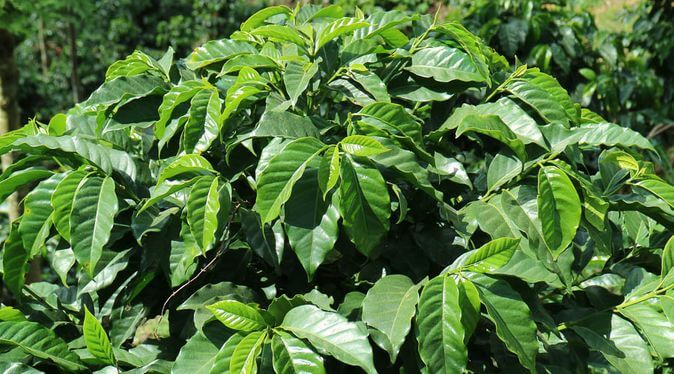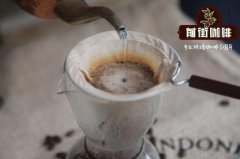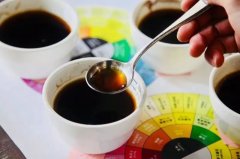Why does coffee smell like burning? Is it normal for coffee beans to taste very burnt?

Professional coffee knowledge exchange More coffee bean information Please pay attention to coffee workshop (Weixin Official Accounts cafe_style)
Many people do not understand the problem of "burning" or "burning" coffee beans in roasting, and the root cause is that there is no unified statement in the industry about the problem of defects in coffee beans during roasting. I really want to talk about the coffee industry today. We don't even know if "Roaster" means human or machine, or whether "Dropping" means pouring coffee beans in or out. Are "tipping" and "scorching" the same thing? These problems need to be studied by us, instead of being closed-door and boasting all day long.
Okay, that's enough of the spit, let's get to the topic of today's discussion: what exactly is "Tipping" and what is "Scorching"?
Definition of "Tipping"
The word "tipping" is understood from its English meaning to mean that one end of the coffee is burned black. At least in my opinion, this understanding is easier to accept. Of course, you can keep your opinions to yourself, but I just want to share my thoughts on the phenomenon of scorch.
How do you know if coffee beans are "burnt"?
The phenomenon of "burning" of coffee beans is caused by the high thermal conductivity coefficient inside the roasting furnace, for example, the energy or heat in a certain area of the roasting furnace is too much, and the coffee beans cannot absorb, transmit or disperse it in a short time, resulting in the coffee beans being burned black.
It's like grilling meat, like in the picture below. The edges of the lamb chops are burnt black because the edges are exposed to too much heat, causing the lamb to be instantly burnt black, while the rest of the lamb is still raw or undercooked. The same goes for coffee beans. If the coffee beans absorb too much heat, the coffee beans will burn black.
Reasons for "burning"
At what time does this phenomenon usually occur? To be honest, we have no way of knowing. Burning can happen at any time. As long as the temperature in the roaster is abnormal, the coffee beans will be burnt, which may occur in the initial stage of roasting, or in the middle or even in the final stage of roasting.
So is "charring" caused by direct heat conduction or convective heat conduction? In other words, is it the oven itself or the hot air inside that burns the beans? The answer is, it's all possible. Scorch is caused by the beans themselves, not their environment, so roasting ovens or hot air can cause coffee beans to scorch, because we just said that scorch is caused by coffee beans failing to absorb, transmit, or disperse too much heat.
Please take a closer look at the picture below:
In the picture, we can observe the temperature change of different parts of the coffee bean. Obviously, the first part of the coffee bean to burn black is the two ends of the coffee bean. Of course, there are exceptions, such as a pod of single coffee beans (Peaberry) because the whole body is round, there is no "two ends" one said, so a pod of single coffee beans occurred "burning" phenomenon probability is slightly lower than the average coffee beans.
The effect of "burning"
How does "burnt" coffee affect the taste of coffee? To this question, I can only say four words: try it yourself!
Quite simply, if coffee gets bad, we must try to avoid "burning" the beans later; if coffee gets good, we must try to replicate this phenomenon later. Can you say lamb chops don't taste good when they're burnt? Of course not, the crispy skin will increase the taste of the lamb chop, making the rest of the lamb more tender and juicy. Therefore, we cannot jump to conclusions about the phenomenon of "burning." Only when you taste it yourself can you form your own judgment.
Why is Starbucks coffee so bitter? Why is dark roast coffee so popular with big coffee chains like Starbucks?
The author of this article explains the differences between the three coffee roasting methods, coffee raw materials and coffee taste from the perspective of quality uniformity, and explains why deep-roasted coffee is favored by large chain coffee companies such as Starbucks.
It wasn't until I was 29, after a year in Costa Rica, that I had my first real cup of coffee.
As an inner-city middle school teacher, I had a soft spot for Diet Coke for six years after I started. I never thought that cup of coffee at El Toledo Coffee Farm would completely change my perception of traditional coffee flavors.
Back in the Midwest, I sampled Starbucks coffee and coffee from our local coffee chain, but found that they were very different in taste.
Indeed, this discovery may make me as fussy about coffee flavors as a barista. Still, I have no resistance to every cup of coffee with a burnt bitterness.
Chemical secrets in coffee beans
I suddenly hate the coke I once loved for the following reasons. Generally speaking, there are three different types of roasting of coffee: light roasting (light), moderate roasting (medium) and deep roasting (dark).
Deep-roasted coffee tastes bitter. This is because when coffee beans are deeply roasted, it is easy to zoom, so the roasted coffee will naturally have a bitter charred taste.
Deep baking is undoubtedly the most common in the United States. It is possible that the coffee that many people drink before has been deeply roasted.
We associate deep roasting with "espresso" that contains a lot of caffeine. In fact, lightly roasted coffee contains more caffeine, but that's a different story.
While roasting coffee in El Toledo, we show visitors how coffee beans change in just a few minutes of cooking and how those minutes can affect the taste of the coffee.
Here are some things you need to know about coffee roasting:
In lightly roasted coffee, the fruity and sour taste will be more obvious. This is because the raw material of coffee beans coffee fruit is fruity and sour.
In moderately roasted coffee, the coffee tastes more balanced and sweeter. This is mainly because the components in the raw materials are heated to form glucose, and the glucose is not dissolved due to overheating.
In deep-baked coffee, the taste is mainly bitter. This is because the coffee beans are easy to zoom in the deep-roasted state, so the roasted coffee will naturally have a bitter charred taste.
Deep-roasted coffee is cheap
In the case of light roasting, the taste of high-quality and low-quality coffee beans is very different. High-quality coffee beans grow at high altitudes, where diverse ecosystems and shady environments make coffee beans ripen more slowly, so they taste better.
Low-quality coffee beans usually come from low-lying farms, where there is either little shade or a single ecosystem. These coffee beans ripen quickly, so the taste in the coffee fruit is difficult to be absorbed by these coffee beans. Causing these coffee beans to taste sour and astringent.
However, because it takes more time to grow high-quality coffee beans and requires higher ecosystem diversity (meaning more space for other plants to grow), high-quality coffee beans generally have lower yields. Low-quality coffee beans can be mass-produced.
For a large chain, it is economically uneconomical to buy high-quality coffee beans and use them to make deep-roasted coffee.
The longer the coffee beans are roasted, the smaller the difference in the quality of coffee beans is.
It can be understood like this: you go to a steakhouse for dinner with a friend. You ordered filet mignon, while your friend ordered beef leg. Obviously, if you all chose rare (equivalent to light roasting of coffee), the taste would certainly be very different.
However, if you order both well-done steaks (equivalent to the deep roasting of coffee), they taste very similar. After all, roasted meat tastes the same-regardless of the quality of the meat.
The same is true of coffee.
Different elevations, farming methods, ecosystems and even weather patterns can have a huge impact on the taste of coffee beans. In deep-roasted coffee, these factors have little effect on the taste of the coffee-because heavy roasting has lost all the flavor.
For a large chain, it is economically uneconomical to buy high-quality coffee beans and use them to make deep-roasted coffee. They can spend less money on low-quality coffee beans, after all, the taste of coffee is about the same after deep roasting, and the profit margin will be greatly increased.
A not-so-bad reason
I don't boycott Starbucks. Although I don't like their coffee, I think as a multinational company, its challenges come from all aspects.
At the same time, I think some practices of Starbucks are worth advocating, such as encouraging suppliers to adopt sustainable operating processes, which has not only brought good performance to the company, but also successfully implemented this initiative beyond the reach of employees.
Bitter, charred deep-roasted coffee is favored by every big chain, and a less evil reason is that deep roasting is the only way to ensure a uniform taste.
As my friend Morgan Housel said:
To gain a foothold in this world, you need to build a strong brand, but to build a brand you have to repeat some business practices and make people believe that the experience of yesterday is the expectation of tomorrow. This is difficult and takes a long time to complete. But if it succeeds, it can build a well-known brand.
You only need to know the truth of success and defeat. After all, you can build a strong brand with inferior products.
That's all I have to say. If we compare the light-roasted coffee bought from El Toledo with the light-roasted coffee bought elsewhere, we will find that the taste is very different.
Different elevations, farming methods, ecosystems and even weather patterns can have a huge impact on the taste of coffee beans.
In deep-roasted coffee, these factors have little effect on the taste of the coffee-because heavy roasting has lost all the flavor. And this hot melting taste is the selling point of light roasted coffee.
No multinational coffee company will make a lot of money on roasting coffee. Even light roasted coffee sold by Starbucks and other companies is of extremely low quality.
The next time you drink lightly roasted coffee in Costa Rica-- or any other coffee-producing country-- you will surely indulge in the faint aroma.
END
Important Notice :
前街咖啡 FrontStreet Coffee has moved to new addredd:
FrontStreet Coffee Address: 315,Donghua East Road,GuangZhou
Tel:020 38364473
- Prev

Household coffee machine: fully automatic or semi-automatic | the difference between semi-automatic coffee machine and full-automatic coffee machine
Professional coffee knowledge exchange more coffee bean information Please pay attention to coffee workshop (Wechat official account cafe_style) Coffee is now a more and more mainstream drink, whether young and fashionable college students or office workers who are busy working overtime are loyal fans of coffee, because they can recharge themselves at any time to provide energy for their study or work. But every day
- Next

What is the best taste of coffee? What should authentic coffee taste like?
Professional coffee knowledge exchange more coffee bean information please follow the coffee workshop (Wechat official account cafe_style) what kind of coffee is a good cup of coffee? Just like asking what kind of person is a good person, there seems to be no correct answer to this question. When you are still in the primary enthusiast stage, you always feel that it must be expensive.
Related
- Beginners will see the "Coffee pull flower" guide!
- What is the difference between ice blog purified milk and ordinary milk coffee?
- Why is the Philippines the largest producer of crops in Liberia?
- For coffee extraction, should the fine powder be retained?
- How does extracted espresso fill pressed powder? How much strength does it take to press the powder?
- How to make jasmine cold extract coffee? Is the jasmine + latte good?
- Will this little toy really make the coffee taste better? How does Lily Drip affect coffee extraction?
- Will the action of slapping the filter cup also affect coffee extraction?
- What's the difference between powder-to-water ratio and powder-to-liquid ratio?
- What is the Ethiopian local species? What does it have to do with Heirloom native species?

